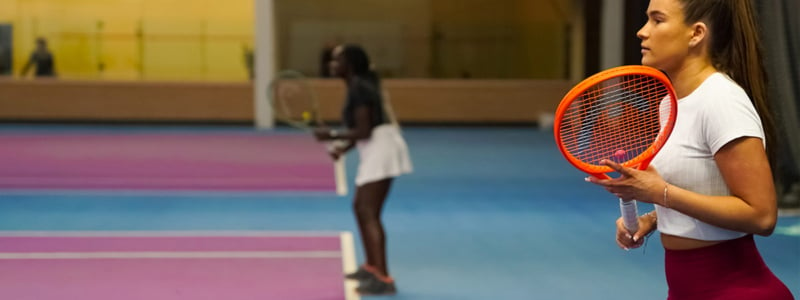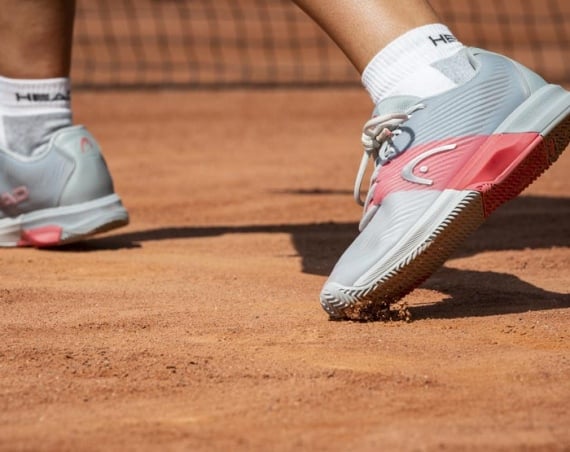Selecting the right equipment is an important factor towards success on the court. That’s true whether you’re new to tennis or keen to see improvements in your game. If you’ve ever borrowed a friend’s racquet and it just felt wrong, you’ll know what we mean. So, it’s worth taking the time to make sure you have the best racquet for your level and the way you play.
Read on to find out how to choose the correct tennis racquet — and how your choice will affect your game.
Racquet size and design impact the way you play
Head Size
The size of the racquet head affects how you contact the ball, which in turn can have an impact on spin and power. Head sizes come in midsize (550-625 cm2), mid-plus (630-680 cm2) and oversized (685-870 cm2).
- Larger head-sized racquets are great for hitting strong groundstrokes and giving you extra power. A larger sweet spot makes them suitable for beginners, but they can be harder to manouvre.
- A smaller head size relies more on the player to generate power. It provides better control for calculated shots though, making it ideal for more advanced players.
Racquet weight
Your upper body puts in a lot of work throughout a tennis match. Choosing the right racquet weight can mean the difference between you finishing a match strongly or waking up the next day with sore arms and regrets. Racquet weight is generally broken down into a couple of classes:
Lighter weight racquets
- Weight: 300g or lower
- Pros: Easier to manoeuvre and control
- Cons: Less powerful
- Best for: Beginners and players who spend time up at the net (especially in doubles)
Heavier weight racquets
- Weight: 310g or higher
- Pros: Great power; absorb shock for more stable play
- Cons: Less agility-focused; the player will need more strength and endurance
- Best for: Intermediate to advanced players and a playing style more focused on baseline groundstrokes.
Grip size
Your racquet should feel comfortable in your hand. Going a grip size too big or too small can lead to injury, so it’s worth getting right. Fortunately, it’s easy to figure out the correct grip size with one simple measurement.
First, look at your hand, palm facing you. Use millimetres to measure from the tip of your index finger down to the second horizontal line on your palm. Compare your measurement to the standard handle perimeters below to find your size.
| Grip Size | Handle Perimeter (mm) |
| 0 | 100-102mm |
| 1 | 103-105mm |
| 2 | 106-108mm |
| 3 | 109-111mm |
| 4 | 112-114mm |
| 5 | 115-117mm |
Frame stiffness
Frame construction plays into how your racquet reacts to a shot and distributes force. Like other aspects of racquet choice, it’s another balance between power and control.
- A stiff frame transfers more energy and more power to the ball but requires your hand and arm to absorb more of the shock of impact.
- A softer, more flexible frame is better for control and reducing vibration from the ball hitting the strings.
Racquet strings
The quality and tension of your racquet strings play a key part in vital elements of the game such as spin, power and control. You don’t need to go overboard as a beginner, but if you’re looking to enhance your performance, there are ways to get your racquet at its absolute best. For strings you may consider:
Pre-strung vs. unstrung
- Buying “frame only” and having racquets strung by the hand of a professional is the way to go to achieve the perfect combination of frame and strings, and makes sense for more advanced players.
- If you’re a beginner or just playing for fun, pre-strung racquets are easier to find and get playing with, and less of an investment.
String tension
- Check your racquet’s tension range and start with a string tension in the middle.
- Increase string tension for better control.
- Decrease string tension to boost power.
Racquet balance
When you pick up another player’s racquet and it just doesn’t feel right, the balance of the racquet may be the reason. Balance, or how weight is distributed on a tennis racquet, is yet another way to fine-tune your equipment. Here’s how balance is calibrated for racquets:
- Balance is “headlight” when it’s heavier towards the handle. Head-light racquets are usually easier to control and better at absorbing vibration from powerful shots.
- Balance is “head-heavy” when the racquet is heavier towards the head. Head-heavy racquets are great for stable, powerful strokes.
Racquet length
Most adult tennis racquets are standard 27-inches.
Kids tennis racquets, meanwhile, start at 17 inches for toddlers and go up to 26 inches for kids aged 9 or 10. When choosing a tennis racquet for your child, look to choose a racquet length that relates to the ball colour they’re playing.
| Ball Colour | Racquet Length |
| Blue | 17-19 inches |
| Red | 21-23 inches |
| Orange | 25 inches |
| Green | 26 inches |
| Standard Ball | 27 inches |

Choose a racquet to suit you
As you’ve seen throughout this guide, there are plenty of ways to find a racquet to match how you play. Racquets should feel right for you as an individual because, after all, everyone plays in their own way on the tennis court.
Don’t forget that our knowledgeable tennis coaches are always happy to provide expert racquet advice. In the meantime, there are plenty of online resources to help you make the right choice, such as the helpful racquet finder tool from leading tennis manufacturer HEAD.
Once you have the right racquet in hand, it’s time to test it out on one of our 850 match-quality courts, indoors and outdoors, across the country. Find out more about tennis at David Lloyd Clubs and how you can be part of our vibrant tennis community.
Find a club



